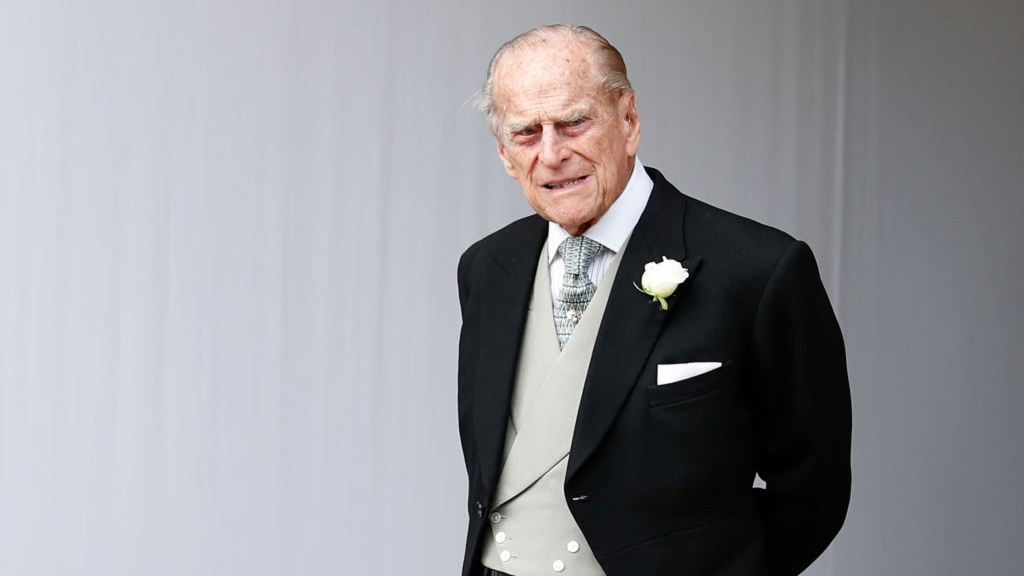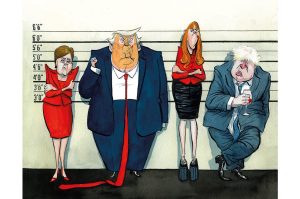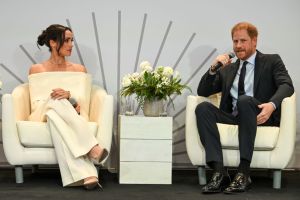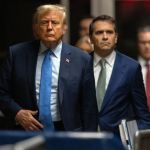Prince Philip played a pivotal, yet often underestimated, role in ensuring the survival of the modern British monarchy. His self-confidence and irreverence served as an invaluable foil for the young Queen Elizabeth, enabling her to overcome her natural shyness and giving her the confidence and stability to reign so calmly and irreproachably for such a long time.
As Britain’s longest-serving consort, he outlasted 14 prime ministers and carried out a staggering 22,000 solo public engagements, joking shortly before his retirement from royal duties in 2017 that he was probably the world’s most experienced plaque-unveiler. When the mathematician Sir Michael Atiyah told the prince how sorry he was to hear he was standing down, Philip riposted in characteristic fashion: ‘Well, I can’t stand up much longer!’
Prince Philip’s achievement was all the more remarkable given that his overtly masculine, forthright and restless character did not obviously equip him to play second fiddle. Yet ever since the Queen’s accession to the throne in 1952, he had been required to address his wife as ‘Ma’am’ in public and to bow whenever she entered a room.
I first had the idea of writing his biography when he was in his late eighties, around the time he broke the record set by Queen Charlotte, George III’s consort from 1761 until her death 57 years later. However, my inspiration was not so much the thought of his extraordinarily enduring public service but rather a story I had read about the prince once asking his equerry to go and meet an extraterrestrial humanoid at a house in Ealing, west London.
Air Marshal Sir Peter Horsley, the said equerry, had been on the prince’s staff from 1952 until 1955, before climbing to great heights in the RAF. ‘Oh God,’ exclaimed an official at the Ministry of Defence, when the equerry’s memoirs came out in 1987, ‘How unfortunate that the public will learn that the man who had his finger on the button of Strike Command was seeing little green men.’
The public also learned that for several years in the early 1950s, Prince Philip had enthusiastically exchanged reports of UFOs with his uncle, Lord Louis Mountbatten, a fellow subscriber to the Flying Saucer Review, and kept himself informed about all the latest developments in the field. As Horsley recalled: ‘Prince Philip was open to the immense possibilities leading to space exploration, while at the same time not discounting that, just as we were on the fringe of breaking into space, so older civilizations in the universe might already have done so.’
According to Horsley, the open-minded young prince ‘agreed that I could investigate the more credible reports provided that I kept it all in perspective and did not involve his office in any kind of publicity or sponsorship’. A select few witnesses were invited to Buckingham Palace to discuss their experiences, partly, as the equerry later explained, to ‘put them on the spot’ and to test their honesty ‘in the presence of royalty, a method as effective as any truth serum’.
This all seemed like good material for a book I was then toying with writing about ufologists in the period just after the second world war. However, the more I looked into Prince Philip, the more it became apparent that his interest in flying saucers was far from being the most interesting thing about him. He was, after all, famously revered as a living god by the islanders of Vanuatu in the South Pacific. Above all, though, I was drawn to the extraordinary story of his childhood, which was so traumatic that in these softer times he might easily have been taken into care by the social services or at least spent the rest of his life in therapy — a notion you can be sure the adult Prince Philip would have scoffed at.
Born on the Greek island of Corfu in 1921, eight years after the assassination of his grandfather, King George I of Greece (an imported monarch from Denmark), Prince Philip was still an infant when a British warship rescued his family from the hands of revolutionaries, a mission instigated by Britain’s King George V — first cousin of Philip’s father, Prince Andrea — who was anxious to atone for having failed to save their fellow first cousin, Czar Nicholas II of Russia, in 1918.
In exile on the outskirts of Paris, the young prince’s world was again thrown asunder in 1930 when his mother, Princess Alice, suffered a severe mental breakdown and was bundled off to a secure psychiatric clinic, and his father abandoned his family to live with his mistress. Philip’s elder sisters would soon be married — all of them to German princes — so the family’s break-up was most keenly felt by their eight-year-old brother, who was now effectively an orphan. For five years he saw his father only occasionally and received no word from his mother, not even a birthday card.
Consigned to the care of his uncles in Britain, he was sent to board at Cheam prep school, then in 1933 to his brother-in-law’s school in Germany, which had been steadily Nazified since Hitler’s rise to power, then, to his relief, back to Britain, and to a new progressive school in Scotland, Gordonstoun, whose spartan educational philosophy made a lasting impression on the embattled prince.
It proved to be a fulfilling and happy time — until further family tragedy struck. In 1937, Philip’s favorite sister and her family were on their way to a family wedding in London when the plane crashed in fog, killing everyone on board. Even before this latest tragedy, the 16-year-old prince had suffered more than his fair share of blows, and perhaps thus fortified he did not break down when he learned what had happened, his headmaster later recording that ‘His sorrow was that of a man’. A few days later, Philip traveled out to the funeral in Germany, and forlornly followed the coffins on foot — just as he would do 60 years later with the Princes William and Harry after the death of their mother, Princess Diana.
Philip’s elder uncle Georgie, the second Marquess of Milford Haven, had come as close as anyone to providing him with love and stability since his mother’s breakdown, but the next year he too died suddenly from cancer, aged 44, and so his more glittering younger brother Lord Louis Mountbatten stepped in to finish the job of bringing his nephew up. Mountbatten had long been impressed with the way that his nephew coped with all the vicissitudes in his life and had his own ideas about what use he could make of his singularly robust and self-reliant character.
It was Mountbatten who orchestrated the fateful meeting between Prince Philip and his cousin Princess Elizabeth at Dartmouth in 1939, when the 13-year-old princess became famously and irrevocably smitten, and he later did all he could to encourage his nephew to press his suit and to remove any obstacles in his path. Monarchists should feel extremely glad that he did so. As the Queen’s ‘strength and stay’ (as she described him) for seven decades, he provided the essential support on which her singularly successful reign depended.
This article was originally published on The Spectator’s UK website.


















